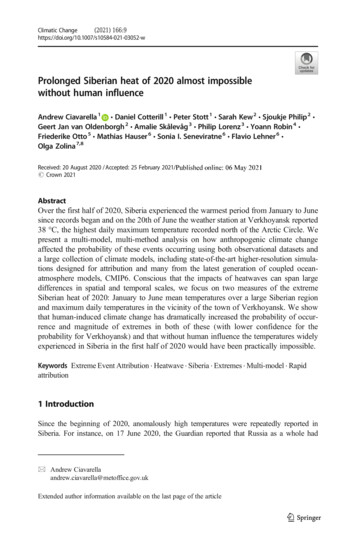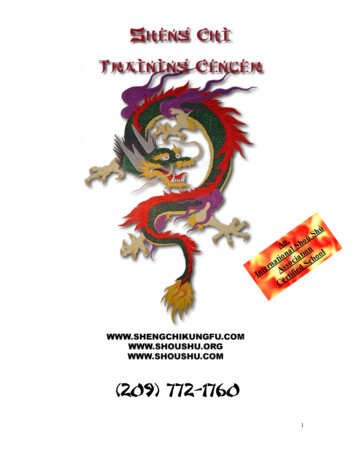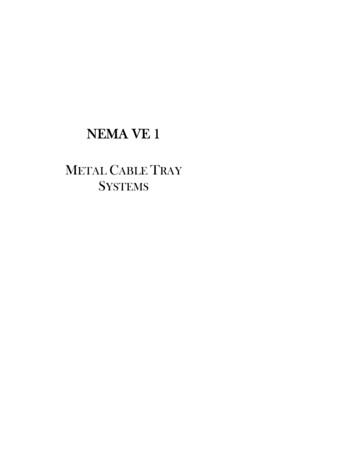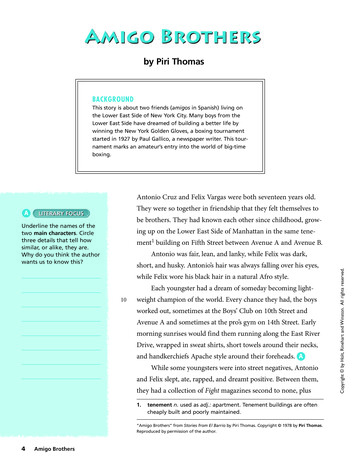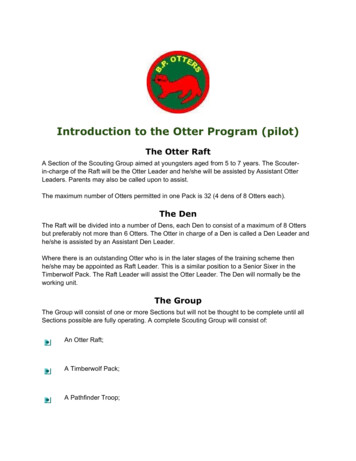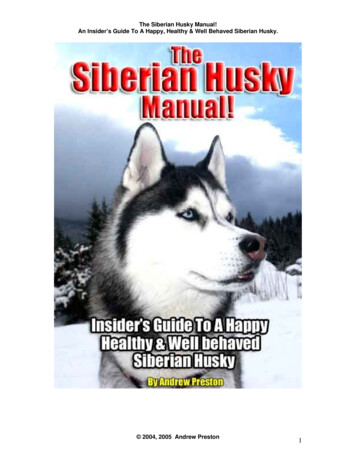
Transcription
The Siberian Husky Manual!An Insider’s Guide To A Happy, Healthy & Well Behaved Siberian Husky. 2004, 2005 Andrew Preston1
The Siberian Husky Manual!An Insider’s Guide To A Happy, Healthy & Well Behaved Siberian Husky.Table Of ContentsForeword4Chapter 1: The Origin & History of the Siberian Husky!5The Siberian Husky today6Chapter 2: A Look at the Breed StandardPhysical DescriptionBreed Standards in a nutshell111115Chapter 3: The Siberian Husky’s PersonalityThe Siberian Husky Personality ChartHunter vs HomebodyChapter 4: Is the Siberian Husky the one for you?The 11 questions you need to answer before you choose a Siberian Husky?Are you the right person for the Siberian Husky?Chapter 5: Where to Find The Right Husky for You?17202122222628How to know if the breeder is reputable?Do you want a male or a female Siberian Husky?9 ways to know that you have chosen the right Siberian Husky?283032Chapter 6: Bringing your Siberian Husky home338 Things you should do when you bring your Sib home:What steps to take to make your Siberian Husky comfortable at home?Some don’ts to remember:Chapter 7: The right diet for your Siberian HuskyWhat is a Healthy Diet for a Siberian Husky?What is a BARF diet?8 ways to know that the diet you are giving is the right one33353840404146Chapter 8: 101 Delicacies for your Siberian Husky48Chapter 9: What you Should Know About Caring and Grooming?72Siberian Husky SheddingGrooming the Siberian Husky coatThe best time to give a Siberian Husky a thorough grooming?Chapter 10: Some Red Alerts That Spell Health ProblemsCommon Health Problems Facing the HuskyThe First Aid Kit for a Siberian Husky727374787880Chapter 11: 23 Keys to a Happy and Healthy Siberian Husky82Chapter 12: How to choose a Vet for your Siberian Husky?84The right way to go about choosing a Vet:And the wrong way : 2004, 2005 Andrew Preston84852
The Siberian Husky Manual!An Insider’s Guide To A Happy, Healthy & Well Behaved Siberian Husky.What is holistic health care?Pet Care Begins at Home8692Chapter 13: Emergency SOS CareWhat to do in an Emergency:9393Chapter 14: Breeding98The Breeding ProcessWhelpingLabor stages:The Newborn Siberian HuskyYour Questions, Our Answers99100101102104Chapter 15: Easy steps to house train your Husky effortlesslyFirst steps to house breakingCrate Training-The best method to house train your Siberian HuskyThe Golden Rules of Housebreaking your Siberian HuskyChapter 16: Introduction to Obedience TrainingTraining yourself to train a Siberian HuskyHow do you begin training the Siberian Husky?Establishing yourself as the AlphaWhy does a Siberian Husky pull at the leash?The Secret to Dog Training106106107110112113114116118120Chapter 17: How To Change Your Siberian Husky’s Temperament For TheBetter121What to do with an aggressive Siberian Husky:How to interpret the behavior of your Siberian Husky?Chapter 18: Caring for your Husky as he AgesWhat are the Signs of Ageing in the Siberian Husky?Your Questions , Our Answers 2004, 2005 Andrew Preston1221251271281343
The Siberian Husky Manual!An Insider’s Guide To A Happy, Healthy & Well Behaved Siberian Husky.ForewordIs that a wolf? No it’s a Siberian Husky! Anyone who has had a Siberian Husky for a pethas often had to answer this question and anyone who has ever lived with one knows thatit takes a special person to rear a Siberian Husky. This strong and sturdy working dog is aloyal companion without being sentimentally sappy, mature yet playful, sociable withpeople and other dogs and has an incredible amount of energy.If you are an outdoor person with a love for trekking and hiking, you will love being withthe backpacking Siberian Husky. They will love lugging a light load and be ready forevery physical challenge. Siberian Huskies are brave hearts who love being where theaction is. Not for then them the fireside - what they want is a something to do. This breedis active, athletic, and intelligent and can rough it out in any kind of weather.Siberian Huskies are pack animals raised around people so they need to have companyaround them. Besides you will need to be there for your Siberian Husky because hisnatural instincts will lead him to dig up escape routes! Owners of Siberian Huskies willtell you the importance of being as agile, alert and intelligent as they are. However,despite their intimidating wolfish looks, Siberian Huskies are amazingly gentle with kidsand aren’t much of guard dogs since they cozy up to strangers. They love toys of theirown and can be quite a bit of the clown and entertain the family with their antics.However don’t let his playfulness fool you into believing that your Siberian Husky willdo your every bid because he isn’t a people pleaser. He’s got a mind of his own and isn’talways up to fetching that stick you throw, though he will happily pull a sled andwhatever else that keeps him busy. There are quite a few challenges of rearing the freespirited Siberian Husky and that’s where this ebook steps in to direct you with what youneed to know about this breed.Find out if you have it in you to be an owner of a Siberian Husky. Read on to find out thehistory of this dog, the accepted breed standard and its unique personality. If you haveone already then follow the guidelines on how you can care for your Siberian Husky inthe best possible way and keep him or her healthy. Take advantage of the advice on theright diet and grooming techniques.Don’t be put off by people who will tell you that it isn’t possible to train the SiberianHusky. Use the training tips to get around the stubborn streak in Siberian Huskies and getthem to be more obedient. Find out what dangers you need to protect them from and whatmakes them content. It all depends on the choices you make for your pet and the patienceyou show.If you are lucky enough to be a Siberian Husky owner, this ebook will be an invaluableguide to a happy and healthy pet. After all, you do owe it to your Siberian Husky tocherish the companionship, reward the loyalty and be his or her guardian angel. 2004, 2005 Andrew Preston4
The Siberian Husky Manual!An Insider’s Guide To A Happy, Healthy & Well Behaved Siberian Husky.Chapter 1: The Origin & History of the Siberian Husky!Where did it all begin for the Siberian Husky? As the namesuggests, it all began in the freezing land of Siberia. A tribeknown as the Chukchi lived along the cold Arctic coast ofnortheastern Siberia, where they hunted for seal and battledthe severe weather. What they needed was a companionhelper who was strong enough to haul their loads ofharvested seals from the Anadyr River, resilient enough totake on the cold and friendly enough to live along with humans. That’s how they came todevelop a breed that we know today as the Siberian Husky but that began as the Chukchidog some 3000 years ago.A dog called ChukchiPicture this- a medium sized dog with adequate fur to keep him warm from the freezingwinter winds and minimum needs when it came to food. During the day he would, thanksto his strength, haul the loads of seals harvested from the Anadyr River with the men ofthe Chukchi and in the evening he would settle around the women and play with thechildren. Herding reindeer was another task they performed without buckling down to thereindeer or the weather.The dogs were so much part of their lives that they were even used as virtual blankets!The dogs were actually made to sleep close to their owners and their children for theirwarmth. It is said that they would speak of how cold the night was in relation to thenumber of dogs they used at bedtime to keep them warm, so they had a “two dog night”or a “three dog night"!The gentleness of this breed sprung from living around the people at such close quartersand pulling the sled along with the rest of the other dogs. The aggressive strand camefrom being let loose in the summer to hunt in packs just as the wolves did. The Chukchidog became so much part of the tribe that it even became a status symbol. Soon thewealth of a Chukchi man was measured by the number and quality of his dogs. TheChukchi dog even became part of many religious beliefs and folklore.Onwards to AlaskaThe importance of their dogs increased even more when the Chukchi tribe managed tooutsmart the Czar’s soldiers who were sent in the nineteenth century to open the area tothe fur trade. The Chukchi dog sleds were faster than the reindeer powered sleds of thesoldiers so for a while the Chukchi people managed to survive till they were finallycornered and overpowered! They continued to live in the region but now that they were‘discovered’ so were their dogs. Around 1908, Alaskan traders came back home withsome Chukchi dogs and decided to call them the Siberian Husky. 2004, 2005 Andrew Preston5
The Siberian Husky Manual!An Insider’s Guide To A Happy, Healthy & Well Behaved Siberian Husky.In Alaska they were used as sled dogs during the gold rush. It was when they ran at the1909 All-Alaska (Nome) Sweepstakes, which is a 408-mile distance dogsled race fromNome to Candle and back that they proved to be better than the bigger freighting dogs.The Siberian Huskies had so much stamina that they could cover almost 100 miles in aday, pulling the sled with or without a load. Since they were much smaller than other sleddogs, people were surprised with their strength and endurance. In 1910 a team of SiberianHuskies driven by "Iron Man" Johnson won the sweepstakes for Charles Fox MauleRamsay. From then on the Siberian Huskies dominated the Nome Sweepstakes andcaught people’s attention.A man called SeppalaOne of the people whose attention they caught was Leonhard Seppala. He was aNorwegian fisherman (later a gold miner) who was given a pack of Siberian Huskyfemales and pups to train, for the 1914 Nome Sweeptakes by his employer. You couldcall him the first official Siberian Husky trainer. He didn’t hit it off very well the firstyear but patience pays and Seppala’s patience led his Huskies to be a hit in NomeSweepstakes in 1925.Another feat that went down in history was a marathon effort of a team of SiberianHuskies during a diphtheria epidemic in the winter of 1925. A life saving drug needed tobe brought into Nome from the far off town called Nenana. It was Leonhard Seppala whoused his Siberian Huskies to deliver the serum to the people of Nome and catapultSiberian Huskies to national fame. People loved them for their heroism.The demand for Siberian Huskies grew especially because: They were strong without being too big. Their nutritional needs were less than that of the bigger dogs. They didn’t need excessive grooming. They could withstand climate extremes. They were sociable enough to live with humans. Their regal looks were irresistible.Thanks to Seppala’s dogs, Siberian Huskies, sled dogs and dog sled racing all became acraze. Some of his dogs toured the USA and more dogs were imported from Siberia.The last Siberian Huskies to be imported from Siberia was in 1930, the year that theSoviet government sealed off Siberia from external trade. It was a good thing that theSiberian Huskies crossed over the Anadyr River to Alaska, were they could be bred as aunique species. It was also in 1930 that the American Kennel Club officially recognizedthe Siberian Husky. In 1939, the breed was first registered in Canada.The Siberian Husky todayEven today Siberian Huskies are used for dogsled racing (though they are often beingreplaced by cross breeds) and are much faster than other pure sled dog breeds like theSamoyed and Alaskan Malamute. Siberian Huskies are also the chosen ones for 2004, 2005 Andrew Preston6
The Siberian Husky Manual!An Insider’s Guide To A Happy, Healthy & Well Behaved Siberian Husky.recreational mushing, for skijoring, a sport where one or three dogs pulls along a skierand European ski-pulka. In fact Siberian Huskies are still mostly either the “racing”kinds or the “show” categories.From working dogs to petsHowever their gentleness has made them popular family pets but don’t forget that theyused to hunt for themselves when the Chukchis set them free in summer, so they stillhave that predator in them very much alive. They are great with human adults and kidsbut they can prove to be quite a threat to smaller animals like cats, rabbits, chickens,squirrels and birds. Owners often use them as companions during hiking or dog packing.As pets they are not high maintenance, with simple dietary requirements and minimalgrooming. They do shed quite a lot and need a good brushing down with a metal combbut they have no doggy smell and are pretty clean animals. They do not need frequentbaths. Overall they are healthy dogs that live up to the age of eleven to fifteen years andthey only face health issues when they grow old. What they need though is a lot ofactivity and exercise. Their diet is decided according to the energy they use.The cute quotientAppearance wise the Siberian Husky can easily get confused for a cute wolf. Despite thewolfish looks, the Siberian Husky does not have any biological link with wolves. It’s apure bred domestic dog. That however doesn’t stop movie Moguls from using them aswolves in the films after all they are so much gentler! They are also beautiful. SiberianHuskies have a very magnificent, powerful look about them. They have double coats thatare mostly black and white, gray and white or copper red and white. They can also bepure white or even have brown, reddish and biscuit shading. Often Siberian Huskies havevery unique facial markings, which look like masks or spectacles and they also havewhite feet and legs, and tail tips that add to the wolfish look.Their eyes are most commonly light blue but some have one blue eye and the other hazelor brown. No matter what color, their eyes are strikingly penetrative and intelligent. For aworking dog that can pull heavy loads, the Siberian Husky is a medium-sized dog,weighing around 35 to 60 pounds (16-27.25 kg). The average height is about 20 to 23.5inches (51-60 cm) but this medium frame packs in more than the strength of bigger dogs.The energy quotientTheir frame belies their energy! They are extremely active and it isn’t a good idea toleave a Siberian Husky alone with nothing to do. They get terribly bored and end updoing the wrong things like chewing and digging. This breed has to be fenced in tightand the fences better be strong and high enough because Siberian Huskies are known todig under the fences, jump over them or find other escape routes. 2004, 2005 Andrew Preston7
The Siberian Husky Manual!An Insider’s Guide To A Happy, Healthy & Well Behaved Siberian Husky.Siberian Huskies are known to be Houdini among dogs and it is better to reinforce thefence with wire netting to prevent them from running off. Remember they are naturalrunning machines, how else do you think they won all those Sweepstakes in Alaska?Once your Siberian Husky decides he’s got to do the great escape act, there is no chasinghim down. Also they have awful sense of direction so they can’t get back home. It’s alsoa good idea to build them a sand box where they can dig for cool spots to their heart’scontent and walk them on a leash. Also if you are professional athlete and runner, youcould clip their leashes to a strong waistband and let your Siberian Huskies give you atraining tip or two.You will need to reign in their energy and channel their strength. Training a SiberianHusky is of paramount importance and the owner must have the decisive upper hand. Ifyou have a Siberian Husky, you need to show him that you are the boss and that you arethe pack commander! This breed is not a one-master kind and that makes things a littlemore challenging but is all the more reason why you need to assume the role of the alphadog. The Siberian Husky needs to be part of your pack.The social quotientYour Siberian Husky might not exactly be possessive of his master but he doesn’t likebeing alone either. He or she likes being around the family members and is good withkids. Siberian Huskies aren’t the fawning type. They are intelligent companions who willact your equal and respect your space. That doesn’t mean that they are serious and dull.They are quite playful and will love wrestling you or playing with toys, but they have acertain sense of maturity in them that doesn’t make them out and out goof ballsThey won’t snap at visiting relatives or your friends. In fact they are social enough toeven welcome strangers, so don’t expect your Siberian Husky to be a guard dog. He isn’tmuch of a barker and he doesn’t have a suspicious streak in him. However his looksmight just do the trick of scaring away any intruders!A Siberian Husky would get along very well with another of his species and also withother dogs but if you have a smaller animal like a cat in the house, you might want torethink about bringing in this working-hunting dog. It’s not that Siberian Huskies aremean and destructive. It’s just that the hunter in them tends to be aggressive towards catsand birds and even sheep. It’s wise to keep them on a leash when you take them on walksbecause they might chase the neighbor’s cat. In any case the leash is important- thoughthey will love you and be loyal because they are part of the pack, they might not listen toyou when you try to call them back.The obedience quotientWell, let’s say that training a Siberian Husky to obey has its challenges. It does not meanin any way that this breed cannot be trained. It just means that you need some extrapatience and firmness. It takes special people to be owners of a Siberian Husky so if youare first time dog owner- do not go for this breed. You need to be a firm, mature and 2004, 2005 Andrew Preston8
The Siberian Husky Manual!An Insider’s Guide To A Happy, Healthy & Well Behaved Siberian Husky.intelligent handler as this is a fairly independent kind of a dog who won’t obey justbecause you love him.What you need to remember though is that Siberian Huskies occupied a very elevatedstatus among the Chukchi people. They will respond when shown the appropriate respect.Any kind of punishment, aggressive behavior and shouting won’t help in trainingSiberian Huskies. They will become more stubborn. However cajoling won’t help either.To train a Siberian Husky you will need to strike a balance and gain his respect. Also ithelps to use a crate and a fenced yard. Show your Husky that you are the pack leader andhe has to listen to you. As a working dog, the Siberian Husky values his human and isbred to be strong, have stamina and also to be loyal. You will just have to win it.In praise of Siberian HuskiesAs a breed, few dogs can match the beauty and endurance of the Siberian Husky. It is ano nonsense, uncomplicated animal that might not be right for everyone but if he or she isthe one for you then you’ve made a great bargain. They are easy to live with and goodnatured as a pet. Siberian Huskies will strike the balance between being a loyalcompanion and an energetic pet. Even if they are known to be dogs that find the greatoutdoors irresistible, they can live in an apartment if they are taken out for enoughexercise. They love to roam but they also really want to be housedogs.The Siberian Huskies have come a long way from being working dogs among theChukchi tribe, lugging sleds and herding reindeer. They have become part of an elitebreed of pets who define their owner as intelligent, mature, energetic and adventurousenough to choose a Siberian Husky for a pet. In return all they need is genuine affection,attention, tender care, firm training, committed friendship and respect.Did you know that ? Research on the DNA of the Siberian Husky proves it to be one of the oldestbreeds among dogs. A popular Chukchi belief was that two Siberian Huskies guard the gates ofheaven so beware anyone who has been cruel to a dog in their lifetime, becausethe Huskies won’t let you in! Most of the Siberian Huskies that are registered today can trace their family treeto that of the 1930 Siberia imports and of Leonhard Seppala’s dogs. Siberian Huskies were used to haul the sleds and be companion-explorers inAdmiral Byrd's Antarctic Expeditions. A statue of Balto, the lead dog from Siberian Husky dog sled team that deliveredthe diphtheria serum to Nome in 1925 stands in Central Park, New York. 2004, 2005 Andrew Preston9
The Siberian Husky Manual!An Insider’s Guide To A Happy, Healthy & Well Behaved Siberian Husky. Some Siberian Huskies are used as therapy dogs. 2004, 2005 Andrew Preston10
The Siberian Husky Manual!An Insider’s Guide To A Happy, Healthy & Well Behaved Siberian Husky.Chapter 2: A Look at the Breed StandardThe Siberian Husky has been around for 3000 years but hiddenaway from the world’s view till it reached Alaska in 1909. Oncethis dog established its claim to being a unique pure bred sled dog,it didn’t take the American Kennel Club (AKC) long to give it theofficial seal of approval. In 1930 the AKC recognized the SiberianHusky and the first AKC registered Siberian Husky was namedFairbanks Princess Chena.The AKC also worked out an official breed standard for the Siberian Husky basicallyintended to maintain the purity of the breed and evaluate the ‘show’ Siberian Huskies.The one who comes closest to the standard, is the best of them all. These breed standardsshould be kept in mind while choosing a pet. There will be a lot of deviations from theideal but that doesn’t make your pet less perfect than other Siberian Huskies. After all,who’s perfect?! These are ideals that breeders need to strive for so as not to dilute thepedigree of the Siberian Husky.Here’s a look at the official breed standard of the Siberian Husky as laid down by theAKC:Physical DescriptionBy now it’s pretty clear that the Siberian Husky is a medium-sized working dog from theoriginal land of the Chukchis. The AKC stresses that the ideal Siberian Husky mustshowcase his heritage, through his appearance. He should be quick, agile, and graceful onhis feet and have a moderately compact body with the adequate amount of fur. What’simportant is that the Siberian Husky should have elegant and graceful actions and gait,with alert, erect ears and a brush tail.The movements of the Siberian Husky should appear to be effortless. Also, again inkeeping with his heritage, the Siberian Husky should be able to function with his harnesson and pull a light load at a good enough speed over great distances. That’s why thegeneral appearance should showcase a balance of strength, speed and stamina. Overallthe look should convey the power and speed that a Siberian Husky packs in his mediumframe.AKC standards also make it clear that a male Siberian Husky should look masculinewithout being coarse and commonplace while the females should look feminine withoutappearing weak. Both the sexes of this species should have a strong structure, firm andwell-developed muscles and no excess weight.Height and weight 2004, 2005 Andrew Preston11
The Siberian Husky Manual!An Insider’s Guide To A Happy, Healthy & Well Behaved Siberian Husky.The AKC lays down that the male Siberian Husky should not be more than 23 ½ inches.The ideal height is between 21 to 23 ½ inches at the withers. As for the females, theyshould be between 20 to 22 inches at the withers. The one disqualification for SiberianHuskies is when they are taller than the upper limit set by the AKC.The weight of the Siberian Husky is seen in proportion to his or her height. The idealweight is set down as between 45 to 60 pounds for males and 35 to 50 pounds for thefemale Siberian Husky. The idea is that the Siberian Husky should not look bulky, orbony or have any weight that is in stark contrast to its height. This breed should be welldeveloped with firm muscles that give it a streamlined look of an active dog. In the showring, Siberian Huskies with too much of bone showing or too much weight can bepenalized.According to the AKC, from a profile view, the Siberian Husky’s “length of the bodyfrom the point of the shoulder to the rear point of the croup should be slightly longer thanthe height of the body from the ground to the top of the withers”.HeadSkull: For this medium sized dog, what is needed is a medium sized head as well. Theskull of the Siberian Husky must be in proportion to his body. It should be a bit roundedon top and then should taper from the widest point in the skull to the eyes. The majorfaults as laid down by the AKC are a head that looks too clumsy or heavy on the dog’sbody and also a head that has a sharply chiseled appearance.Expression: Expression matters a lot in the Siberian Husky and the AKC mentions in thebreed standard that the dog should look keen, friendly, interested and even mischievous!The bored uninvolved look is out- the expression should exude the energy of the SiberianHusky.Eyes: This is probably the only breed that does not have a prescribed eye color. They canbe blue or brown. They can also have one brown and one blue eye. The AKC also allowsparti-colored eyes as well. The eyes should be almond shaped and be set slightlyobliquely with enough space between the eyes. With regard to the eyes, the only faultsare when the eyes are either too obliquely set or too close with no moderate gap.Ears: A Siberian Husky’s ears shouldn’t be too large. They should be medium size, thickears with a nice triangular shape. They should be close fitting ears that are set higher upon the head. The ears should also have the right amount of fur. A Siberian Husky shouldhave ears that just arch at the back a bit and tips should be slightly rounded. They shouldalso stand up straight, with the rounded tips pointing straight up too. According to theAKC the major faults of a Siberian Husky is when the ears are too large, or set apart toowide or not strongly erect. 2004, 2005 Andrew Preston12
The Siberian Husky Manual!An Insider’s Guide To A Happy, Healthy & Well Behaved Siberian Husky.Stop: The stop of the Siberian Husky, which is the indented part of the skull between theeyes, should be well defined. Also the bridge of the nose should be straight from the stopto the tip. AKC lays down an insufficient stop, as a fault.Muzzle: The front parts of the jaw, which is called the muzzle, should be of mediumlength. Basically it means that the distance from the tip of the nose to the stop should besame as the distance from the stop to the occiput, which is the back of the head. Themuzzle should be medium width and taper off gradually to the nose. The tip of themuzzle should not be pointed or square. The faults listed by the AKC are when themuzzle is too snipy or too coarse; too short or too long.Nose: A Siberian Husky’s nose differs according to their coat color. Gray, tan or blackSiberian Huskies have black noses while copper dogs have liver-colored noses. A purewhite Siberian Husky has a flesh-colored nose. Even a pink-streaked "snow nose" is anacceptable breed standard.Lips and Teeth: According to the AKC standards, the lips of a Siberian Husky should be“well pigmented and close fitting”. As for the teeth- they must close in a scissors bite. Itis considered as a fault if a Siberian Husky has any bite other than a scissors bite.Neck, Topline, BodyNeck: Breed standards demand that a Siberian Husky should have a neck that is heldproud and erect when he stands. The neck should be of medium length and appropriatelyarched. When the Siberian Husky moves, the neck should extend and move slightlyforward. A neck that is too short, too thick or too long, are seen as faults.Chest: A Siberian Husky should have a deep and strong chest and the deepest pointshould be just behind and level with the elbows. The chest should not very broad and theribs should be well sprung but flat at the sides, so that there is room for free movement. Achest that is too broad or has barrel ribs is a fault. Also ribs that are too flat or weak areseen as faults.Back: It’s a must that a Siberian Husky’s back be straight and strong. That means thetopline should be level from the top of the shoulders, which is called the withers, down tothe croup or the rump of the dog. The croup should slope away gently from the spine butnot at a very steep angle, as this would interfere with the movement of the hind legs. Theback should be of medium length and definitely not slack. The loin (which refers to thepart of the body on both sides of the backbone, just between the ribs and the hips) shouldbe also taut, lean and narrower than the rib cage. There should be a slight tuck-up though.A back, which is weak or slack or with a sloping topline is considered to be a fault in aSiberian Husky.Tail: The tail of the Siberian Husky should be of a fox-brush shape and set right belowthe level of the topline. It needs to be covered adequately with fur, but the hair shouldn’tbe too long and be of the same length all over so that the tail gets a round, bushy look.When the dog is alert, the tail should bend elegantly over the back in a sickle curve. The 2004, 2005 Andrew Preston13
The Siberian Husky Manual!An Insider’s Guide To A Happy, Healthy & Well Behaved Siberian Husky.tail should not curl to a side or lie flat on the back but it is alright for the tail to trail whenthe Siberian Husky is at rest. According to the AKC guidelines though, a very snapped ortightly curled tail is a fault. It is also a fault if the tail is over-plumed or set too low or toohigh.ForequartersShoulders: The shoulder blade of the Siberian Husky should be well laid back and theupper arms should not be perpendicular to the ground. Instead they should be angled a bitbackward from the shoulder to the elbow. The muscles and ligaments that bind theshoulder to the rib cage should be strong, well developed and firm. Straight or looseshoulders are seen as faults.Forelegs: From the front, the forelegs should be moderately spaced, parallel and straight.The elbows should be close to the body and must not turn either in or out. From the side,the pasterns, which are the part of the leg b
An Insider's Guide To A Happy, Healthy & Well Behaved Siberian Husky. Table Of Contents Foreword 4 Chapter 1: The Origin & History of the Siberian Husky! 5 . Crate Training-The best method to house train your Siberian Husky 107 The Golden Rules of Housebreaking your Siberian Husky 110 Chapter 16: Introduction to Obedience Training 112 .
